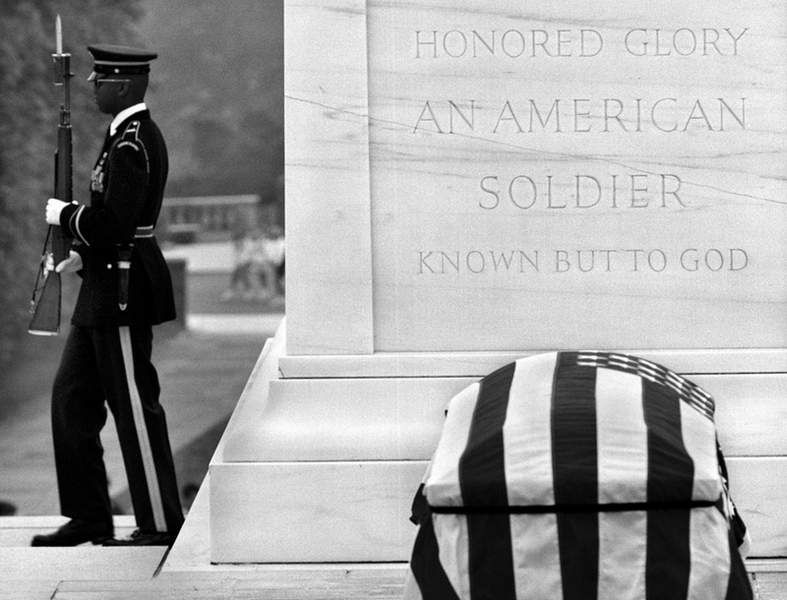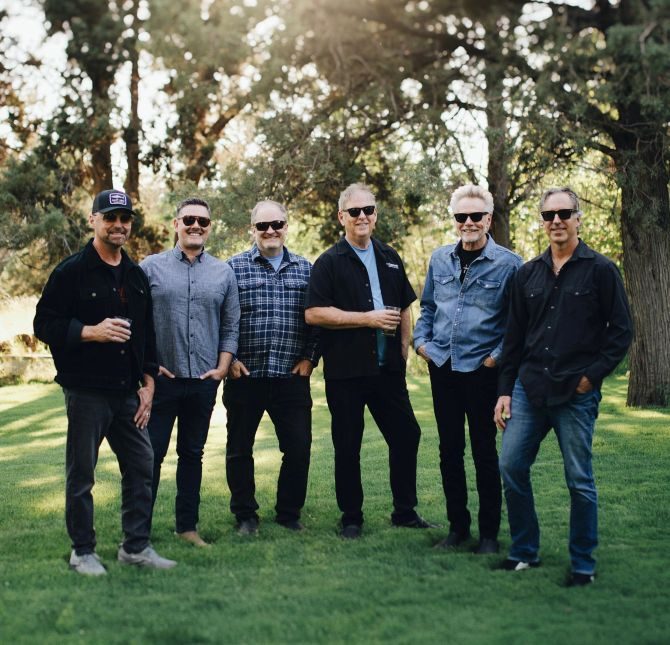Hearts and bones: the soldier who wasn’t unknown
Published 4:00 am Sunday, November 11, 2012

- Jean Blassie, center, mother of Air Force 1st Lt. Michael Blassie, and his sister Patricia, right, now an Air Force colonel, talk with reporters at Arlington National Cemetery on May 14, 1998, after Michael Blassie’s remains were disinterred from the Tomb of the Unknowns.
Air Force Col. Patricia Blassie rolls a black suitcase into the living room of her neatly furnished home near Denver. She opens it and pulls out a piece of nylon flight suit.
“This was Michael’s,” she says, carefully placing it on the coffee table before reaching back into the suitcase.
Out comes part of a pistol holster, followed by a portion of parachute, then a flattened one-man life raft that she unfolds on the floor. After all this time, the rubber raft is stiff and cracked.
These reminders of the last seconds of her brother’s life were found in South Vietnam, where his plane crashed in flames 40 years ago.
Also recovered were six human bones, originally identified as her brother’s, then reclassified as “unknown.” It would take decades, but eventually those bones would help solve one of the U.S. military’s longest-running cases of mistaken identity.
In post-Vietnam Washington, what began to matter most was putting the divisive conflict to rest, moving debate about Vietnam from politics to history by honoring an anonymous soldier killed in the war. The problem was finding one.
“In the end, all you have is your name,” says Patricia Blassie, as she packs away her brother’s things. “When that’s taken away, you’re left with nothing. We just wanted Michael’s name back.”
May 11, 1972
Lt. Michael Blassie, a 1970 graduate of the Air Force Academy, learned to fly A-37s at Columbus Air Force Base in Mississippi. When he took off from the American base in Bien Hoa that May morning, Blassie, who had arrived in South Vietnam less than four months earlier to join the 8th Special Operations Squadron, had already flown 130 combat missions.
Shortly after starting his initial strike on an artillery position outside An Loc near the Cambodian border, a burst of tracer rounds was seen coming toward Blassie’s plane. His flight commander, Maj. James Connally, described what happened next in a letter to Blassie’s parents: “Mike’s aircraft was hit and began streaming fuel. He must have been killed instantly, because he did not transmit a distress call of any kind. The aircraft flew a short distance on its own and then slowly rolled over, exploding on impact in enemy-held territory.”
The day following Blassie’s death, his parents in St. Louis were visited by an Air Force chaplain who informed them that their son had been killed in action, but his body could not be recovered. This would be the same official explanation the Blassie family would hear for the next 26 years.
“My father, who served in Normandy during World War II, never got over losing Michael,” says Patricia Blassie, who was 13 years old when her brother, the oldest of five siblings, died. “He and Michael were very close. Dad set up a little memorial in the basement and would go down there all the time and just sit.” George Blassie, Michael’s father, died in 1991.
Nearly six months after Blassie’s plane was shot down, a South Vietnamese army patrol located the crash site. A short distance away it made another discovery, reported in a radio log: “1 U.S. pilot’s body with ID Card, 1st LT BLASSIE, MICHAEL JOSEPH, and one Beacon radio and two compasses and one US flag and one parachute.” A rubber raft, portions of a holster and a flight suit were also found. The “body” consisted of six bone fragments.
Among the personal belongings recovered was a wallet. Inside, a photograph of Blassie’s family. The American operations officer in An Loc, Army Capt. William Parnell, kept the remains with him that night.
The next morning, the bones and other items were placed in a plastic bag and handed to a departing helicopter crew chief.
On Nov. 2, 1972, they were turned over to the Saigon Mortuary, where Army Capt. Richard S. Hess signed off on the list of items received, including the wallet and Blassie’s ID. From South Vietnam, the bones — and a skeletal chart with the notation: “BTB [Believed to Be] Lt. Blassie, Michael Joseph” — were sent to a search and recovery center at Camp Samae San, Thailand, and then, in 1976, to Hawaii for analysis at the Army’s Central Identification Laboratory (CIL-HI). Missing from the items listed as received in Vietnam were the wallet and ID, which had been lost or stolen between there and Hawaii.
Tadao Furue, chief physical anthropologist at the Hawaii facility, began identifying Korean War casualties in 1951. In cases with little to go on, Furue, now deceased, would attempt to calculate age, height and other characteristics from bone fragments — a controversial technique he developed called “morphological approximation.”
In a letter dated Dec. 4, 1978, Furue wrote that after “processing” the remains in the Blassie case, the age was estimated to be 26 to 33 years. “Blassie was 24 years 1 month 7 days at the time of his death and this is outside the estimated age bracket,” he wrote. The “living stature at the time of death” was estimated to be between 65.2 and 71.5 inches. Blassie’s height was 72 inches. It was also determined, by testing a single hair found in the portion of flight suit, that the “blood type of the remains disagrees with the recorded blood type ‘A’ for Blassie.”
Furue recommended that the bones be reclassified and “designated unknown.”
But the laboratory’s procedures, which frequently seemed like guesswork, according to Samuel Dunlap, employed at CIL-HI in the 1980s, were beginning to raise questions in the Defense Department and the scientific community.
Never notified
Blassie’s family in St. Louis was never informed by the military that the wreckage of his plane had been located or that remains were recovered, the same remains that were stored at the Army’s Central Identification Laboratory in a file labeled X-26.
Better battlefield medical care, speedier evacuation of the wounded and a more thorough accounting of the dead meant that by the early 1980s, there were only four sets of unknown Vietnam-era remains. Two were subsequently identified; a third was considered to be non-American; and a fourth set — X-26 — was only 3 percent complete, far less than the customary 80 percent deemed suitable for burial in the Tomb of the Unknowns.
“Some very powerful people” wanted a Vietnam Unknown buried in Arlington, says John Marsh, secretary of the Army at the time and now an adjunct professor of law at George Mason University. “The president wanted it done. Congress had authorized it. And we had the assurance of the person in charge that the remains in Hawaii were unknown.”
Army Maj. Johnie Webb, a decorated Vietnam veteran, took charge of the Central Identification Laboratory in Hawaii in 1982. He was familiar with the Blassie case. He also understood the signals Washington was sending.
Webb says, Army headquarters in the Pentagon took steps to make sure the remains destined for Arlington would never be identified. On April 4, he says, he was ordered to remove from the X-26 file any information connecting Blassie to the Vietnam Unknown.
It was at this point, in what he describes as “the struggle of my life,” that Webb decided to stop following orders. He began writing memos for his personal file, and instead of destroying the crash-site items — some of which, such as the life raft, could be tied directly to Blassie — he hid them in the one place no one would ever look.
“I’m a Vietnam vet,” Webb says. “I had to do what was right. I put the evidence in the casket …with X-26.”
May 28, 1984
“Today, we pause to embrace him and all who served so well in a war whose end offered no parades, no flags, and so little thanks,” said President Ronald Reagan at the burial ceremony.
Then, placing the Medal of Honor on the flag-draped casket, the president said his final emotional farewell: “Thank you, dear son, and may God cradle you in his loving arms.”
In 1994, Patricia Blassie was a captain in the Air Force and living in Marietta, Ga., when she received a phone call from Ted Sampley. The former Army Green Beret told her he had just written an article for the Vietnam veterans’ newsletter he published proving that her brother was buried in the Tomb of the Unknowns.
“We wanted to know what happened to Michael,” Blassie says. “But finally finding out was a shock.”
For Patricia Blassie, then working in the Air Force Office of Public Affairs in the Pentagon, the latest turn of events had serious implications.
“I never wanted to embarrass the military or the country,” she says. “I just wanted to know the truth. We all did. And there was only one way to do that.”
Jean, Michael’s mother, said: “For 26 years, we have been told that Michael was never found. Yet, he was found five months after he was shot down and then buried without our knowledge in the Tomb of the Unknowns. … I want to bring my son home.”
Tests were performed at the Armed Forces Institute of Pathology. The results showed a perfect match with DNA samples provided by Blassie’s family. The institute’s scientists also reported that, when the casket was opened, they found the crash-site artifacts that Central Identification Laboratory Commander Johnie Webb had put inside 14 years before.
If political pressure led to a known soldier being buried in the Tomb of the Unknowns, it was her family’s determination that “helped us find Michael,” Blassie says. “We had the opportunity to rebury him in Arlington Cemetery, but we wanted to bring him home.”








